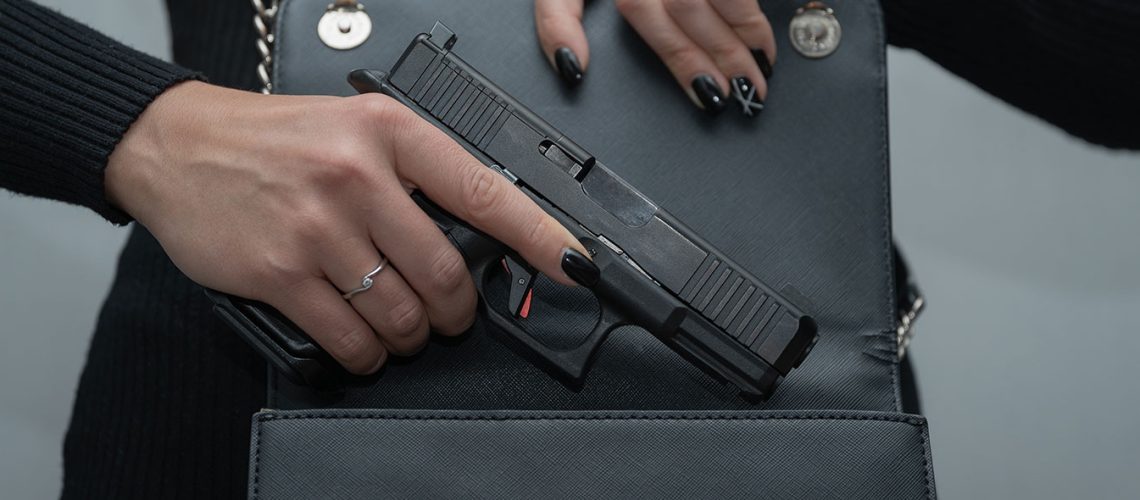Carrying off-body (in a backpack, handbag, etc.) vs. on-body (belt holster, shoulder, holster, ankle holster, or belly band) is one of the more contentious topics in the world of personal carry.
There are good points on both sides, but like most things, context is extremely important.

Carrying off-body means carrying with you, but your firearms are not directly on your person. Off-body carrying usually means a separate item like a pistol bag, fanny pack, purse, or other container that’s with you, but not on you.
From a perspective of “immediate response,” carrying off-body might not be as good as carrying on-body—but it’s clearly better than not carrying at all. With that in mind, it’s worth considering ways to add off-body carry to your personal defense plan.
REASONS TO OFF-BODY CARRY
Convenience. When you can’t on-body carry—or when it’s just not practical (swimming, for example) off-body carrying can be the next best thing to your on-body carry.
Comfort. Wearing on-body just isn’t comfortable in a lot of situations. A long car ride. While hiking a long distance on a sweltering day. Or with clothes that make it particularly difficult to conceal your own body carry (like a tight shirt or sweater). Off-body can solve the comfort issue while providing a nearby handgun. Most instructors would recommend trying to solve the comfort issue by using a different holster (some are definitely more comfortable than others!) or carrying in a different on-body position before separating the gun from your body. But sometimes, that’s just not possible; it’s still better to have a gun in your backpack than not to have one at all.
Which brings about a conflicting gray area. Even some of the most fervent on-body advocates, and many instructors, sometimes carry off-body. The “car gun” and the “purse gun” are two prominent examples.
Easy to carry. With an anchored holster inside, your off-body carry is simple to transport. It’s in the bag.

No printing. Although someone might clock your off-body carry bag for what it is, there’s no printing. You could be carrying, or you might not. And there’s no way to determine make, model, or caliber.

Adds versatility to your carry options. While your on-body carry must be sized within parameters that make it concealable on your person, no such limitation exists with an off-body carry. So, you don’t have to carry a weapon based on personal concealment. An off body carry bag can easily accommodate a larger handgun with RDS.
DISADVANTAGES
“I would prefer you not carry than carry off-body. That’s how dangerous this mode of carry actually is.”
–Neil Nemetz, Geauga Firearms
That’s how one firearms company owner feels about off-body carry. And to be sure, there are some disadvantages to off-body carry that should be factored into your decision.
Slower to draw. Clearly, an off-body carry will result in a slower draw, due to having to remove your firearm from a bag or other off-body container. If the extra second or two is too long, then off-body carry is not for you.
Easier to steal. When it’s not attached to your body, and it’s in an inviting container or bag? Yeah, it’s going to be easier to steal. (Especially if it’s out of your reach.)

Loss of control. Even if you do a vigilant job of looking after your off-body carry bag, you’re just not going to have the same level of control over your firearm as your on-body carry provides. Because the weapon isn’t as quickly or readily under the control of your grip, you’ve consciously given up at least some measure of control.
Youth handgun safety. It is always a bad idea to store a handgun where it can be accessed by children or strangers. In many states it is decidedly illegal. Carrying off-body can increase the chances of access by others, depending on your home or work situation. This should be an especially important safety consideration if you are thinking about toting a firearm in a bag.
TIPS
Use the right carry bag or container. Every person and every situation is different, so not every person will use the same kind of off-body carry. However, get one that will in most situations suffice as your off-body carry bag. If you have an idea of how you will most often use this carry, select your type or style of bag on that basis.
Cover that trigger! Off-body carry doesn’t mean you shouldn’t be using a holster. Make sure the gun is contained and the trigger is covered. You don’t want anything getting in that trigger guard and interfering with the operation of the trigger. Many manufacturers make pocket holsters that work well for carrying your firearm inside of a bag.
Get something specially designed to hold a firearm. Naturally, if you select something particularly designed to be an off-body carry, you’ll realize the benefit of having a bag created for the purpose you intend—without having to create your own solutions with a more general use type of bag.
Dedicated pocket or holder for your firearm. Whether your off-carry bag is “homemade” or specifically designed for the off-body carry purpose, your bag needs a distinct, dedicated pocket or holster for your firearm. Due to the slower draw that accompanies an off-body carry, fishing around for your firearm isn’t an option.
Practice accessing it—frequently. Also due to the slower draw, it’s even more necessary than with an on-body carry to frequently practice drawing the weapon. Being able to access your off-body carry quickly and consistently is essential. Split seconds can make a difference here.
SHOULD YOU, OR SHOULDN’T YOU?
While off-body carry can offer comfort and convenience with other advantages, it can also slow down access and draw time. Again, carrying off-body is often better than not carrying at all, but every gun owner will have to determine whether an off-body carry option is appropriate for them.

